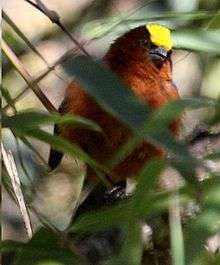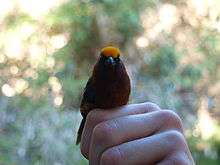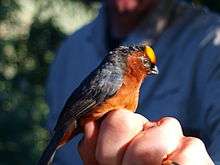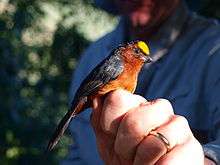Plushcap
The plushcap (Catamblyrhynchus diadema) is a species of bird in the family Thraupidae and it is the only member of the genus Catamblyrhynchus.
| Plushcap | |
|---|---|
 | |
| Scientific classification | |
| Kingdom: | Animalia |
| Phylum: | Chordata |
| Class: | Aves |
| Order: | Passeriformes |
| Family: | Thraupidae |
| Genus: | Catamblyrhynchus Lafresnaye, 1842 |
| Species: | C. diadema |
| Binomial name | |
| Catamblyrhynchus diadema Lafresnaye, 1842 | |
The plushcap is one of the most distinctive of all Neotropical passerines in both its appearance and behavior. The plushcap (Catamblyrhynchus diadema) was in its own family until recently when it was grouped with the tanagers. It is very distinct both physically and in its behavior. The bill is broad and black. The body is a chestnut color with a bright golden-yellow forecrown. The forecrown is made up of stiff feathers. It has been speculated that these short, dense feathers are less susceptible to feather wear and more resistant to moisture than typical feathers. This may be an adaptation for its specialized feeding mode, in which it probes into dense whorls of bamboo for its prey items (Hilty et al. 1979). Juveniles are just duller versions of their parents. They are found at high elevations from northern Venezuela south to Argentina, including the coastal mountains of Venezuela and the Andes of Colombia, Ecuador, Peru, Bolivia, and extreme northwestern Argentina. They live in montane forests and secondary forests near bamboo. They forage for insects inside the bamboo. They will eat small insects, berries, and small plant matter.
The bird is very distinct and is not confused with many other birds. It stands out from the other tanagers, only possibly being confused with the golden-crowned tanager despite the golden-crowned tanager being blue. The species is found in Argentina, Bolivia, Colombia, Ecuador, Peru, and Venezuela. Its natural habitat is humid montane forests and it is always found in close association with Chusquea bamboo. It is typically found at elevations between 1,800 and 3,500 m.

Taxonomy
There are three subspecies: Catamblyrhynchus diadema citrinifrons, Catamblyrhynchus diadema diadema, and Catamblyrhynchus diadema federalis. The subspecies citrinifrons is found in Peru and has a paler cap while the federalis is in coastal Venezuela and is brighter than diadema.
Description
The plushcap is about 14 cm (5.5 in) long and males weigh on average 14.9 g (0.53 oz) and females 13.4 g (0.47 oz).[2] It has a chestnut body and a golden-yellow forecrown (the plush part of the name). From its nape to its wings, it is black. The males and females look the similar but the males are slightly larger than the females.

Vocalizations
While the plushcap is usually quiet, when it does vocalize it has a long series of chirps and twitters.
Habitat
Plushcaps prefer to live in montane forest or secondary woodland by Chusquea bamboo which they use to find food. They stay at high elevation, between 2,300–3,500 m (7,500–11,500 ft).[1]
Distribution and conservation status
Plushcaps are considered of least concern due to their wide range in South America but it is thought that the number of individuals is declining. They tend to be common in their range.
Diet
The diet consists of small insects, berries, and plant material, and they typically forage in small groups within mixed species flocks of wide diversity. The plushcap looks for insects by probing and pushing its bill into the stems and leaf nodes of the bamboo and prying them open. They also forage by running their bill along the stems of bamboo with a series of tiny biting motions. Plushcaps will often hang upside down while searching for the insects.

References
- BirdLife International (2012). "Catamblyrhynchus diadema". IUCN Red List of Threatened Species. 2012. Retrieved 26 November 2013.CS1 maint: ref=harv (link)
- Salinas, A.; Burns, K. J. (22 September 2010). Schulenberg, T. S. (ed.). "Plushcap (Catamblyrhynchus diadema)". Neotropical Birds. Ithaca, New York: Cornell Lab of Ornithology. doi:10.2173/nb.plushc1.01. Retrieved 14 August 2019.
Further reading
- Krabbe, N.; Flórez, P.; Suárez, G.; Castaño, J.; Arango, A. D.; Duque, A. (2006). "The birds of Páramo de Frontino, western Andes of Colombia" (PDF). Ornitología Colombiana. 4: 39–50.
- Greeney, H. F.; Nunnery, T. "Notes on the breeding of north-west Ecuadorian birds". Bulletin of the British Ornithologists' Club. 126 (1): 38–44.
- Ridgley, R. S.; Greenfield, P. J. (2001). Birds of Ecuador. New York. p. 759.
- Restall, R.; Rodner, C.; Lentino, M. (2007). Birds of Northern South America. New Haven. p. 674.
- Harris, T. (2009). Complete Birds of the World. Washington, D.C. pp. 358–360.
- "Catamblyrhynchus diadema". Integrated Taxonomic Information System. Retrieved 14 August 2019.
